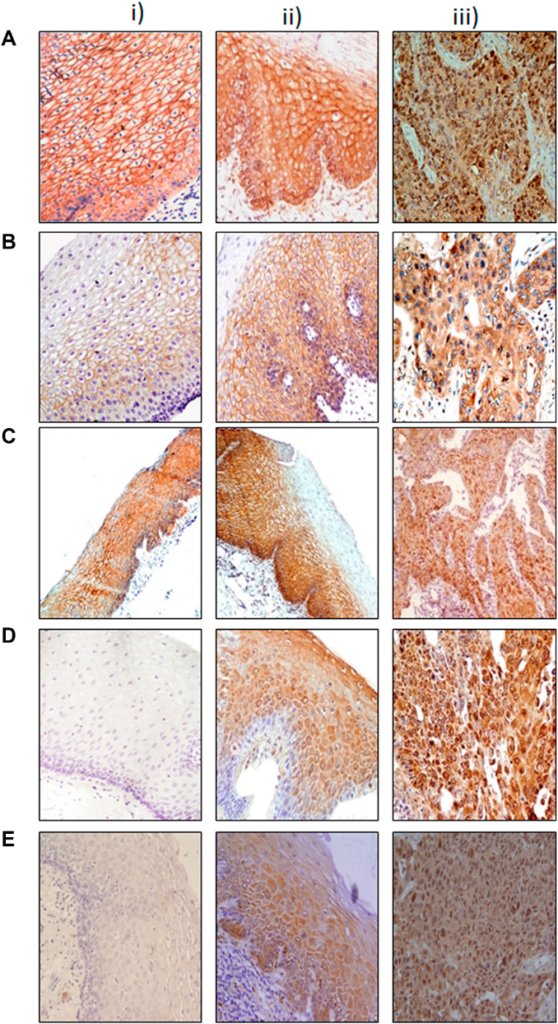Researchers developed a multi-protein expression-based risk model to predict recurrence-free survival for ESCC patients.
The Trending With Impact series highlights Oncotarget publications attracting higher visibility among readers around the world online, in the news, and on social media—beyond normal readership levels. Look for future science news about the latest trending publications here, and at Oncotarget.com.
—
Esophageal cancer is the sixth most common cause of death from cancer worldwide. The two main types of esophageal cancer are adenocarcinoma and esophageal squamous cell carcinoma (ESCC). ESCC arises from the cells lining the esophagus, and it is most common in areas of the world where tobacco use and alcohol consumption are high.
“Biomarkers to predict the risk of disease recurrence in Esophageal squamous cell carcinoma (ESCC) patients are urgently needed to improve treatment.”
Researchers Raghibul Hasan, Gunjan Srivastava, Akram Alyass, Rinu Sharma, Anoop Saraya, Tushar K. Chattopadhyay, Siddartha DattaGupta, Paul G. Walfish, Shyam S. Chauhan, and Ranju Ralhan from All India Institute of Medical Sciences, Mount Sinai Hospital Toronto, McMaster University, Guru Gobind Singh Indraprastha University, and the University of Toronto conducted a new study on the protein expression-based risk model they developed to predict recurrence-free survival for ESCC patients. On September 14, 2022, their research paper was published in Oncotarget’s Volume 13, and entitled, “Prediction of recurrence free survival for esophageal cancer patients using a protein signature based risk model.”
The Study
“Our study is important because: (i) it is based on changes in expression levels of the biomarker proteins in different subcellular compartments and is not limited to alterations in the overall protein expression levels; (ii) investigates the comprehensive clinical relevance of subcellular alterations in expression of multiple key components of Wnt pathway in the same ESCC patients’ cohort; (iii) correlates these findings with disease outcome and (iv) develops a Biomarker risk score for defining the risk of recurrence of ESCCs.”

The researchers aimed to develop and validate a panel of biomarkers with the potential to predict tumor recurrence in patients with ESCC, as well as to generate a risk model for clinical decision-making. This study enrolled 80 ESCC cases, 61 esophageal dysplastic tissues and 47 normal tissues. A multi-protein signature was generated from microarray data using the Cox proportional hazard model which was then internally validated on an independent set of samples by immunohistochemistry. The researchers demonstrated that a panel of four biomarkers (cytoplasmic β-catenin, nuclear c-Myc, nuclear DVL and membrane α-catenin) constituted the prognostic molecular signature for ESCC patients. They found that this protein signature could predict disease recurrence in patients with ESCC.
“Our panel of biomarkers predicted disease recurrence more effectively as compared to individual biomarkers analyzed in this study and demonstrated the strong predictive power of this panel of biomarkers for ESCC patients.”
Conclusion
The research team found that a panel of four biomarkers could predict disease recurrence in patients with ESCC. Furthermore, they showed that this protein signature could be used to stratify patients into high- and low-risk groups. This study provides valuable insights into the role of these proteins in the development and progression of esophageal cancer. The development of this risk model may help to tailor treatment and follow-up strategies for patients with ESCC.
“In conclusion, integrated analysis of expression of the panel of 4 proteins in ESCC patients has allowed us to validate the robustness of our biomarker panel in stratification of patients at high or low risk of disease recurrence. This risk classifier has the potential to identify the high risk patients for more rigorous personalized treatment and the low risk patients may be spared from the harmful side effects of toxic therapy as well reduce the burden on health care providers. The findings of our study set the foundations for external validation of the prognostic signature as a step forward in translation of this panel of protein markers for ESCC patients and establish their clinical relevance for larger worldwide application in future studies.”
Click here to read the full research paper published by Oncotarget.
ONCOTARGET VIDEOS: YouTube | LabTube | Oncotarget.com
—
Oncotarget is an open-access journal that publishes primarily oncology-focused research papers in a continuous publishing format. These papers are available at no cost to readers on Oncotarget.com. Open-access journals have the power to benefit humanity from the inside out by rapidly disseminating information that may be freely shared with researchers, colleagues, family, and friends around the world.
For media inquiries, please contact media@impactjournals.com.



